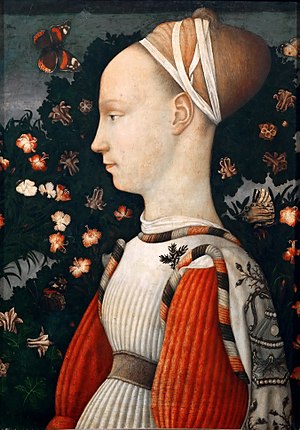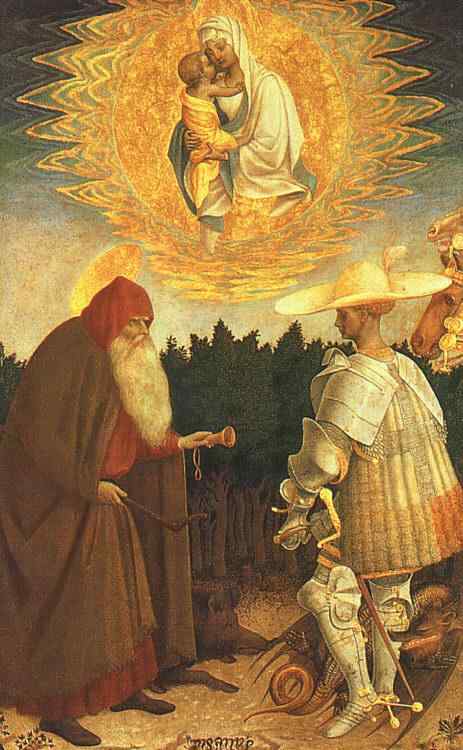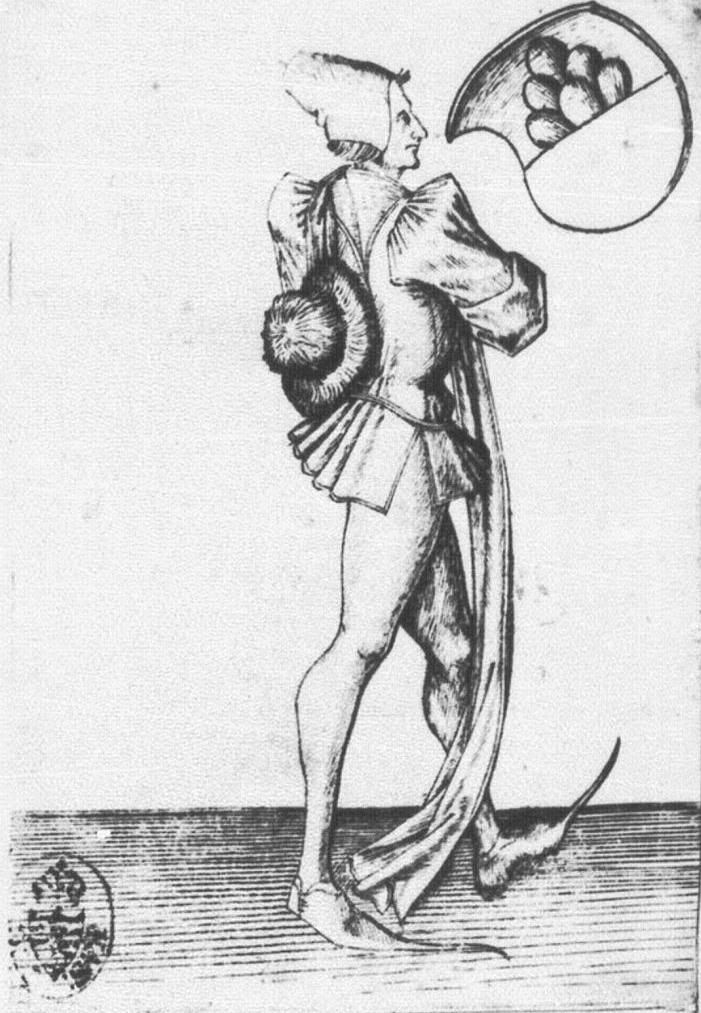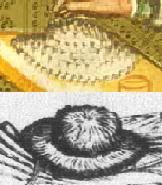Huck
Rosanne said:Regardless of nay-sayers, there seems some particular association with the Visconti/Sforza milan families and Straw Hats.
It was very odd to see a picture of Saint George, accepted as commissioned by Fillipo Visconti, Bianca's Father, with a large Straw Hat on his head. If anyone can point me to a similar painting of Saint George with a straw hat, I would be very pleased. So you have Visconti with a desire to have this portrayed- why? Then you have another Duke with a possible poor man's Straw hat on the table- a person who was literally poor, taking over from a wealthier Duke. It seems there is some connection.
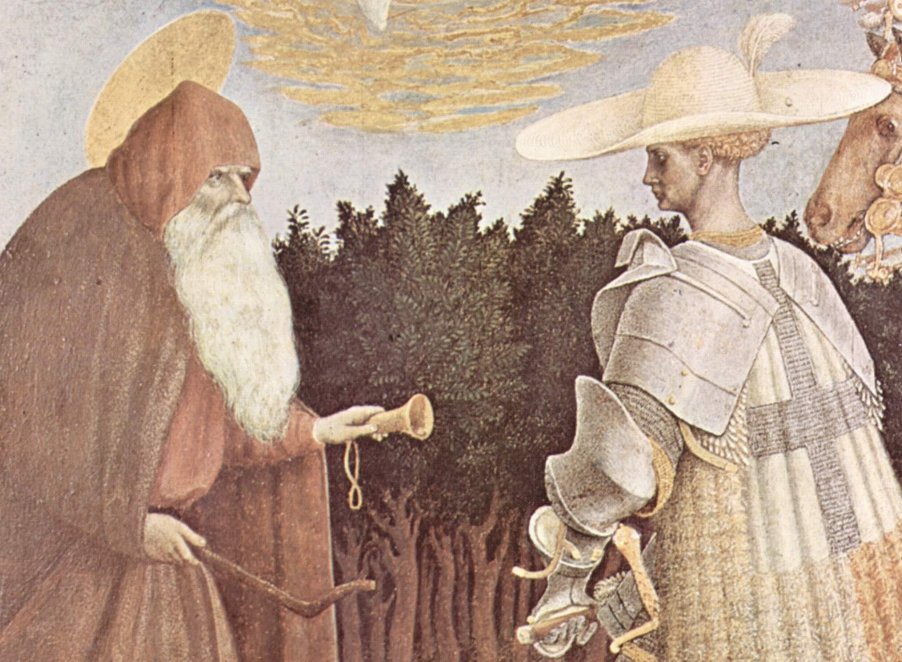
I think, there is some hesitation to accept, that it was made for Visconti ... also I'm not sure, if it's really a straw hat.
But it's easy to accept, that Pisanello shows generally exaggerated hats (as also others) in this time.
Ross showed this picture recently ...

http://www.wga.hu/frames-e.html?/html/d/domenico/bartolo/speda2.html
you can see the enlargement at the link location.
.. about the same time from Siena in a hospital scene. It's remarkable, that we have "only ONE exaggerated hat" in central position between many other more humble ways to protect the head.
It seems to say, that highest nobility used the rather exaggerated hats to dominate the scene, but the normal "real" hat market got its commissions from guilds, who were interested to show their profession in the hat form. And this clothing was determined (at least in this early time) by practical and functional viewing points.
We accept that hats and purses are symbolic of a profession on one hand, but do not on the other hand accept that this was a symbolic Hat, with another situation. Is every smile in an art work, a Mona Lisa smile?
I have not been able to confirm the tourist patter about the incident in Fermo, but why would this anecdote remain all these years?
As a lot of anecdotes remained and somehow often look a little bit unlikely ...
It's simply difficult to present a hypothesis too much depending on such anecdotes. If it's possible to show the plausibility of the anecdote content by arguments from more realistic perspectives, it becomes better for the hypothesis.
Then once again we have a comment about the Hat Straw in Milan in the siege, which cannot be confirmed(we have a historic account of the siege who had no interest in Tarot) ...
I thought, you've read this, so why it is not confirmable "as a researcher opinion"?
Well, that sounds interesting ... as it somehow might relate to Sforza's debts in 1438 and also Sforza's debts in 1452.... , but we have a painting in 1445, that seems to indicate that Straw hats had some meaning. It could be taken as, rather than a magician, this card represented a soldier who had hung up his Hat, or that
it indicated the change of Dukes.
There is a history of straw hats indicating debt- from the parades on Saint John the Baptist feast day.
I cannot tie these in together with a magician- but really I am not interested in that. The man wears red- indicating lowly status- except when a Cardinal wears it.
I think, that the color red was expensive. The many red hats in Florence surely don't indicate, that these people all were poor.
I think, that the Magician card lives just from this contrast, a noble red clothing (indicating a rich person), but a worn straw hat at the table (indicating person with debts).
In Meisner's Karnöffel poem from c. 1450 the Karnöffel robs another person and takes his clothes. One result of such an activity would be a ...
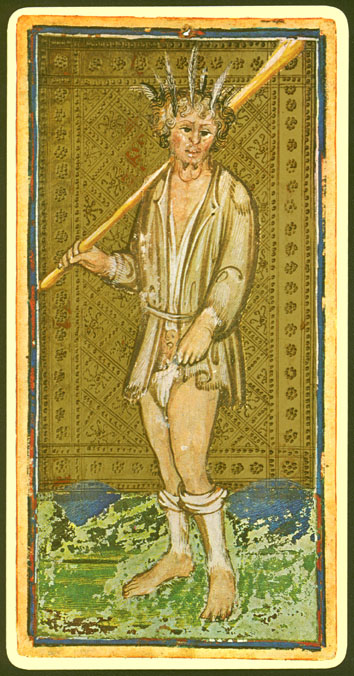
... a man more or less without clothes ...

... and another a man with "stolen" clothes, noble dressed, but with some indication, that it is a robber (for instance: the straw hat).
Well, it's a natural result of some gambling, something which often appeared during card games, at least in metaphorical meaning.
The game of 1452 (a 5x14-game according a specific well-known theory) had been plausibly descended from the Imperatori cards and the Karnöffel game (also called Keyser="Imperatori" Spiel). So the figures in the deck of 1452 have a natural relationship to these older variants.
The Karnöffel game itself developed from another natural relationship to the chess game.
Since the writing of Cessolis (1300) the both pawns before the rooks had gotten the iconography of a bad clothed farmer (who often looked a little foolish) and a messenger/player figure with 3 dice in his hands - this one was clothed in the way of a noble men.
The rooks were the strongest figures in the early way to play chess - with a weak Queen figure and a weak bishop. As this were the "highest trumps", it was logical to place the "lowest trumps" before them
Another prototype, which developed, were the "two servants", which appeared in early theater plays - they were used to provoke funny elements inside the plays. Comedies were preferred.
So all this had in its basis line already an old tradition. The straw hat might have been a new element, a new interpretation.

